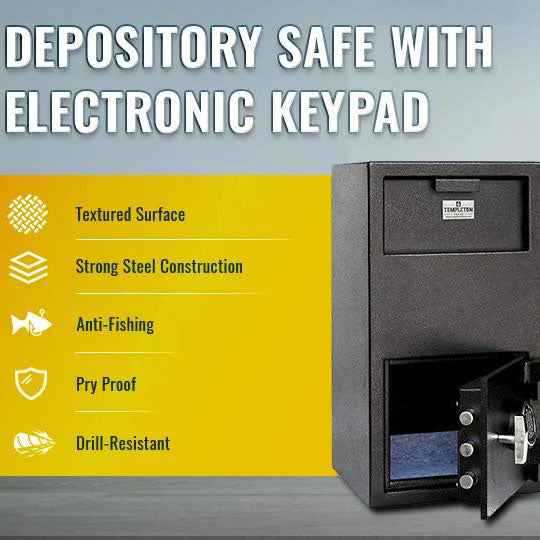Safeguarding Classified Documents: A Deep Dive into Government Safes
In the world of government offices, safeguarding sensitive information is paramount. Whether it’s classified documents, confidential files, or valuable assets, having robust security measures in place is non-negotiable. Enter government safes—the unsung heroes that protect our nation’s secrets.
In this comprehensive guide, we’ll explore the ins and outs of government safes, their features, and why they matter. So, grab your metaphorical magnifying glass, and let’s dive into the world of secure storage!
Why Government Safes Matter
Government safes serve as the frontline defense for safeguarding classified documents, confidential files, and valuable assets crucial for national security. They are not just mere storage units but rather the stalwart protectors of our nation's most sensitive information and assets. Classified documents, ranging from top-secret intelligence reports to diplomatic cables, find secure refuge within these safes, ensuring that only authorized personnel have access to them.
Additionally, government safes play a vital role in asset protection, offering a secure haven for valuables such as weapons, cash, and historical artifacts. Moreover, adherence to strict legal compliance regarding data protection and storage is imperative for government agencies, and government safes ensure that these regulations are met effectively, providing peace of mind amidst heightened security concerns.
Types of Government Safes
High-Security Safes
High-security safes are akin to modern-day Fort Knox, boasting robust features designed to thwart even the most determined intruders. Their thick steel walls provide formidable resistance against brute force attacks, ensuring that unauthorized access is virtually impossible. Advanced locking mechanisms, including electronic keypads, combination locks, and biometrics, add an additional layer of security, granting access only to authorized personnel with the appropriate credentials. Moreover, these safes are equipped with fire and water resistance capabilities, ensuring the preservation of sensitive materials in the face of unforeseen disasters.
Fire-Resistant Safes
Fire-resistant safes are indispensable for protecting vital documents and sensitive materials from the ravages of fire. Featuring specialized fireproof insulation, these safes effectively mitigate heat transfer, keeping internal temperatures low and ensuring the survival of critical records during a blaze. Whether it's safeguarding important paperwork or preserving digital media, fire-resistant safes provide an essential layer of defense against unforeseen fire hazards, preserving the integrity of sensitive information and assets. Templeton Safes offers fire-resistant safes. Check out our collection here to learn more about our selection that can thwart fires and protect sensitive information.
Biometric Safes
Embodying futuristic security technology straight out of a James Bond film, biometric safes offer cutting-edge protection through advanced authentication methods. Utilizing state-of-the-art fingerprint scanners, these safes grant access only to authorized personnel whose biometric data matches the stored records, effectively preventing unauthorized entry. Additionally, some biometric safes feature retina scans, further enhancing security by utilizing the unique characteristics of an individual's eyes as a means of identification. With biometric safes, access control reaches new heights of sophistication, ensuring unparalleled security for sensitive information and assets.

Choosing the Right Safe for Government Offices
When selecting the appropriate government safe, several factors come into play to ensure optimal security and functionality.
Size and Capacity
Determining the size and capacity of the safe is crucial in meeting your storage needs effectively. Assessing your requirements involves considering both present demands and future growth projections. Whether it's accommodating a growing volume of documents or expanding asset storage, choosing a safe with adequate space is essential. Additionally, incorporating shelves and compartments within the safe facilitates efficient organization, ensuring easy access to stored items while maximizing storage capacity.
Locking Mechanisms
The choice of locking mechanism significantly impacts the security and accessibility of the safe. Electronic locks offer the advantage of quick access, but it's imperative to maintain confidentiality regarding access codes to prevent unauthorized entry. Alternatively, combination locks provide a classic yet reliable means of securing the safe, requiring a unique sequence of numbers or symbols for access. For enhanced security, biometric safes utilize fingerprint recognition technology, granting access exclusively to authorized personnel based on their unique biometric data.
Tamper-Proof Features
Safeguarding against tampering attempts is essential for maintaining the integrity of the safe's contents. Reinforced hinges eliminate potential weak points, ensuring that the door remains secure under duress. Anti-drill plates serve as an effective deterrent against burglary attempts, thwarting the efforts of would-be intruders by fortifying vulnerable areas of the safe's construction.
Installation and Maintenance
Proper installation and regular maintenance are vital to the continued effectiveness of the government safe.
-
Placement Matters
Strategic placement of the safe is essential for maximizing security and accessibility. Whether installed in closets, basements, or secure rooms, selecting strategic locations minimizes exposure to potential threats while ensuring convenient access for authorized personnel. Additionally, anchoring the safe to a sturdy surface prevents theft by thwarting attempts to remove the safe from its location.
-
Regular Inspections
-
Check the Seals
-
Lubricate Locks
Conclusion
In conclusion, government safes are more than just steel boxes—they are the silent sentinels that safeguard our nation's most critical secrets and assets. Investing wisely in the right safe is paramount, ensuring optimal protection for classified documents and sensitive materials. By considering factors such as size, locking mechanisms, tamper-proof features, and proper installation, government agencies can enhance their security posture and mitigate potential risks effectively. Remember, it's not paranoia—it's preparedness!






























